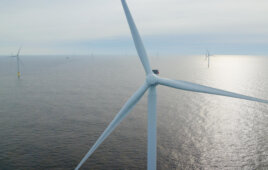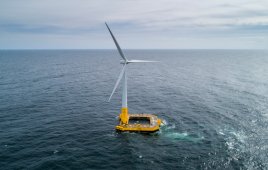On May 27th, the U.S. Dept. of Energy (DOE) announced three projects are eligible to receive $40 million in funding. DOE stated “The Atlantic City Windfarm developed by Fishermen’s Energy, Lake Erie Energy Development Corporation’s Icebreaker project, and the University of Maine’s New England Aqua Ventus I project have demonstrated significant progress toward being successfully completed and producing power. These three projects are each eligible for up to $40 million in additional funding in future project performance periods after reaching specific milestones, subject to congressional appropriations and progress reviews.“ More details are available on the DOE website.
With roughly 80% of the U.S. electricity demand originating from coastal states, offshore wind is a crucial renewable resource to be incorporated in the country’s clean energy mix. Since 2012, the U.S. Department of Energy has supported a portfolio of advanced wind energy technology demonstration projects that represent some of the nation’s most innovative offshore wind projects in state and federal waters. These demonstrations are among the first of their kind making their way through permitting, approval, and grid interconnection processes in the United States. The demonstrations will help address key challenges associated with installing full-scale offshore wind turbines, connecting offshore turbines to the power grid, and navigating new permitting and approval processes.
In May 2016, DOE identified three projects from its offshore wind portfolio— Lake Erie Energy Development Corporation’s Icebreaker project, the University of Maine’s New England Aqua Ventus I project, the Atlantic City Windfarm developed by Fishermen’s Energy — that have demonstrated significant progress toward being successfully completed and producing power. These three projects are each eligible for up to $40 million in additional funding in future project performance periods after reaching specific milestones, subject to congressional appropriations and progress reviews.
Lake Erie Energy Development Corp. Project Icebreaker
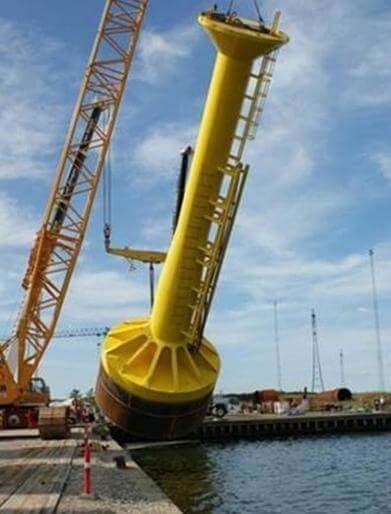 LEEDCo plans to install six 3.45-megawatt direct-drive turbines on Mono Bucket foundations seven miles off the coast of Cleveland in Lake Erie.
LEEDCo plans to install six 3.45-megawatt direct-drive turbines on Mono Bucket foundations seven miles off the coast of Cleveland in Lake Erie.
The Mono Bucket foundation was selected through significant engineering analysis, and is expected to reduce installation time, costs, and environmental impacts compared to traditional foundations that require pile driving. The Mono Bucket not only is a solution for the Great Lakes, but also has broader national applicability for offshore wind installations off the Atlantic and Gulf Coasts.
LEEDCo has assembled a credible, experienced team to support project development, and will also address technical challenges unique to fresh water offshore wind deployments such as icing.
U of Maine’s New England Aqua Ventus I
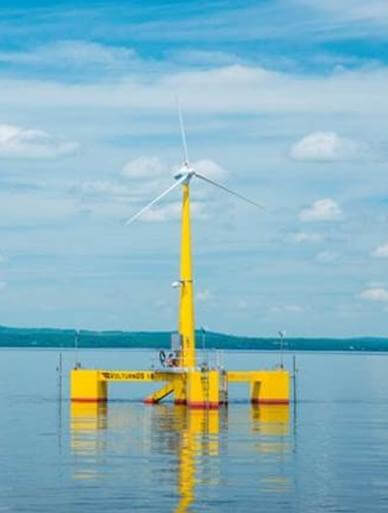
The University of Maine has demonstrated a 1:8-scale prototype of their floating VolturnUS foundation,
The University of Maine plans to install a pilot floating offshore wind farm with two 6-megawatt direct-drive turbines on concrete semi-submersible foundations at a test site off of Monhegan Island, Maine.
Because of its location in deep waters off the coast of Maine, where traditional foundations are not feasible, the University of Maine is developing an innovative floating platform.
The University of Maine has demonstrated a 1:8-scale prototype of their floating VolturnUS foundation, and they have applied the knowledge gained in designing, constructing and deploying the prototype to the engineering efforts of the full-scale design. The University and its partners have made significant progress on the engineering design of the full-scale foundation by focusing on commercial-scale manufacturing of the foundation and reducing costs. These considerations have led to significant reductions in the internal steel requirements and vastly improved manufacturability of the foundation.
Fishermend’s Energy Atlantic City windfarm
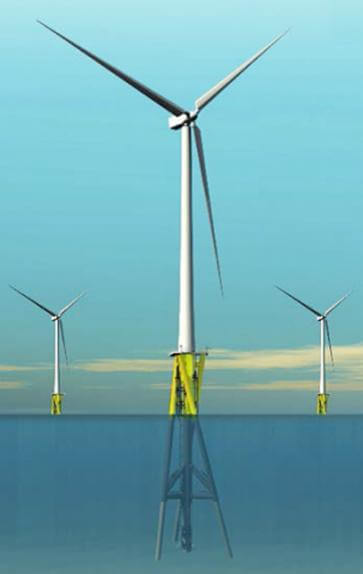
Fishermen’s has teamed up with foundation developer Keystone Engineering to demo a new access ladder that is rotated 90 degrees, bringing maintenance vessels closer to the turbine foundation while allowing the worker to side step onto the ladder.
Fishermen’s Energy of New Jersey plans to install six 4-megawatt Siemens turbines in state waters approximately three miles off the coast of Atlantic City, New Jersey. Fishermen’s Energy Atlantic City Windfarm will demonstrate the use of a twisted jacket foundation that is easier to manufacture and install than traditional foundations, helping drive down the cost of energy produced by the offshore wind system.
To ensure the safety of the workers who will service the offshore turbines, Fishermen’s has teamed up with foundation developer Keystone Engineering to demonstrate a new access ladder that is rotated 90 degrees, bringing the maintenance vessel closer to the turbine foundation while allowing the worker to side step onto the ladder.
During operation, the Fishermen’s project will act as an at-sea laboratory to further our knowledge about offshore wind, investigate the interactions between turbines, test new control systems, and provide information about potential environmental impacts of offshore wind while reducing the levelized cost of energy from offshore wind.
Filed Under: Construction, Offshore wind



